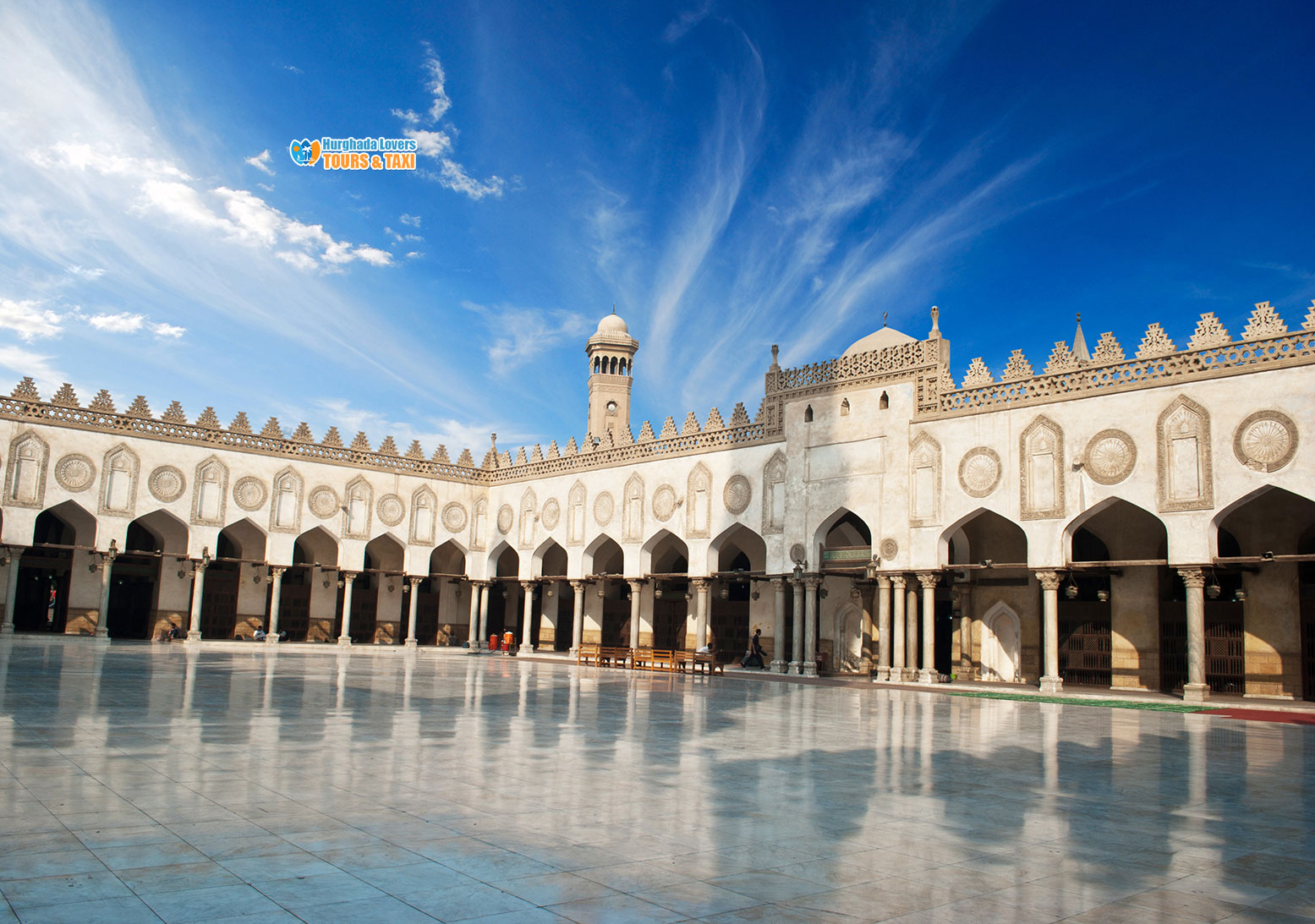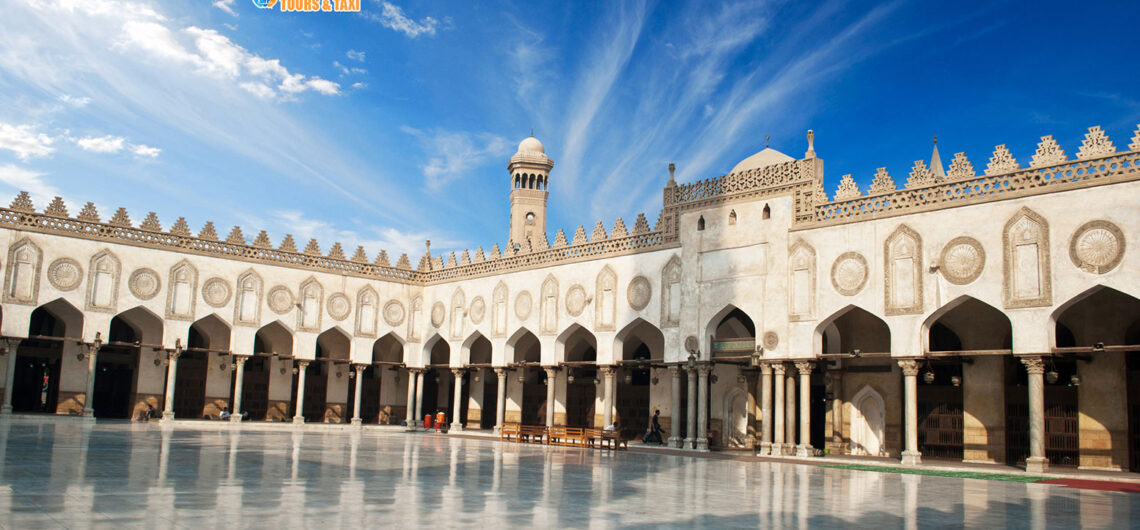Al-Azhar Mosque in Cairo, Egypt
Facts and history of the establishment of the most famous Islamic Historical mosques in the Islamic world, who built Al-Azhar Mosque, the design of the mosque from the inside and more about the most important Islamic Egypt Archaeological Sites.
Al-Azhar Mosque Facts
Al-Azhar Mosque is one of the most important Islamic Egyptian Antiquities and monuments and mosques in Egypt. It is considered one of the sources of knowledge and the spread of Islam, and it is even a source of knowledge for Muslims around the world, not just for Egyptians.
In addition to its archaeological importance, learn more information about Al-Azhar Mosque to discover the Islamic Egypt History below..
Who is the founder of Al-Azhar University?
Al-Mu’izz li-Din Allah is the founder of Al-Azhar Mosque..
When was Al-Azhar Mosque built?
Construction began in 970 AD and lasted until 972 AD..
How many minarets are there in Al-Azhar Mosque?
There are 4 minarets in Al-Azhar Mosque..
The history of Al-Azhar Mosque and what are the most important minarets, schools and gates in the mosque, as it is considered one of the most important Islamic historical monuments in Egypt, and what is the role of Al-Azhar in the Islamic world and more.
The mosque was built in 969 AD, corresponding to 359 AH, when Commander Jawhar al-Siqilli, the ruler of Egypt and commander of the Fatimid Caliphate, al-Mu’izz li-Din Allah, gave orders to build the largest and oldest Islamic university in history and around the world..
The mosque is located on Al-Azhar main street, which extends from Sayedna Al-Hussein Square to Ataba Square, the most famous Old Cairo neighborhoods.
At first, the mosque was built as a large mosque for the city of Cairo. In the year 378 AH, the mosque was converted into a large mosque for teaching jurisprudential and religious sciences to students from all over the world..
A special law was issued for Al-Azhar Mosque in 1961 AD to become a scientifically advanced Islamic university while preserving religious teachings and traditions..
You can visit the mosque and walk around it provided that you take off your shoes. You can carry them in your hand or put them in the cupboard in the mosque..
Al-Azhar Mosque is distinguished by its high minaret, as its upper body consists of 17 ribs and is covered from the outside with the finest types of faience tiles and ends with two heads, as it was built during the reign of Sultan Al-Ghouri in the year 920 AH corresponding to 1514 AD in the fifteenth century..
When you enter the hallway, you will see a large courtyard and pointed arches from the Fatimid era and the 10th and 11th centuries AD, in addition to the teaching areas for students and the dome located at the main entrance to Al-Azhar Mosque..
Over the course of 1000 years, the mosque witnessed major expansions from the inside until it reached its current state, in addition to the original columns and some old columns that were in the place before the mosque was built. Sultan Qaitbay renovated the entrance to the original mosque in 891 AH, then Sultan Abd al-Rahman Kankhuda carried out expansions in it in 1167 AH..
The foundation stone for the construction of the mosque was laid on the 14th of Ramadan 359 AH, corresponding to 970 AD, until the construction was completely completed in the holy month of Ramadan in the year 361 AH, corresponding to 972 AD..
Al-Azhar Mosque was named Al-Azhar Mosque because it is located at the end of Al-Azhar Street. Some interpretations say that the reason for the name is in honor of Fatima Al-Zahra, the daughter of the Prophet Muhammad, may God bless him and grant him peace..
Sunni doctrine, Islamic Sharia and Islamic law are taught at Al-Azhar University to Egyptian students and expatriates from around the world..
The mosque can accommodate more than 2,000 worshippers.
Bab Al-Sa’aida was founded by Sultan Abd al-Rahman Kankhda
Bab Al-Shorba was established by Sultan Abd al-Rahman Kankhda.
Bab Al-Mazneen was established by King Abbas Hilmi II
Minarets:
The minaret of Aqbaghaia Abd al-Wahid was established in 740 AH during the Fatimid era.
Sultan Qaitbay Minaret, established in 891 AH during the Fatimid era
The Minaret of Qansur al-Ghouri has two heads and was established in the year 915 AH during the Fatimid era.
The minaret of Sultan Abdul Rahman Kankhda was established in 1167 AH during the Ottoman era.
Schools:
Al-Taybarsiya School is located to the right of the main entrance and was established in 709 AH during the Mamluk era.
Al-Aqbaghawiya School is located to the left of the main entrance and was established in 741 AH during the Mamluk era.
Jawhar Al-Qanqabi School was established in 844 AH during the Mamluk era.
Buried figures in Al-Azhar Mosque:
Southern Corner Tomb of Sultan Abd al-Rahman Kankhda
The eastern corner tomb of Sultan Jawhar al-Qanqabi
The main niches in Al-Azhar Mosque:
Warrior of the Sicilian essence
Warrior of Sultan Abdul Rahman Kankhda
Information about Al-Azhar Mosque
The construction of Al-Azhar Mosque dates back to the Fatimid era, which came after the conquest of Egypt by Jawhar al-Siqilli in 969 AD..
Jawhar al-Siqilli began the establishment of Cairo and built the Grand Palace. After that came Caliph al-Mu’izz li-Din Allah, who began building this mosque..
The aim of building this mosque was to have a city mosque and an educational institute for the Shiite sect and to spread it..
it built in the Fatimid architectural style, and despite the restoration operations that have taken place over the ages until now, which have changed the features of the architectural style..
However, it is still considered one of the oldest Fatimid monuments..
Al-Azhar Mosque is considered one of the oldest universities in the world. It is the first in Egypt to play the role of a school and an institute..
In the past, mosque lessons were given based on a mandate from the state, and scholars and teachers were paid for the lessons..
The fall of the Fatimid state was a strong reason for the decline in the prosperity of the mosque at the hands of Saladin Ayyubi, who was fighting the Shiite sect..
The sermon remained suspended in the mosque for 100 years until it was restored by the Mamluk Sultan Al-Zahir Baybars Al-Bunduqdari..
During the reign of King Fuad I, he issued a law establishing the faculties of the principles of religion, Sharia, and the Arabic language. In 1961, the mosque became an independent university..
What is behind the name of Al-Azhar Mosque?
The mosque was initially called the Mansouriya Mosque, but during the reign of Caliph Al-Mu’izz li-Din Allah, he named the city Cairo, and thus the mosque became known as the Cairo Mosque..
Al-Azhar is the masculine form of the word Al-Zahra, which is the title of Lady Fatima, the daughter of the Messenger of God, may God bless him and grant him peace, and the wife of Ali bin Abi Talib..
Al-Azhar Mosque in the Ottoman era
At the beginning of the Ottoman Caliphate, Al-Azhar Mosque gained great respect from the Ottomans, as Sultan Selim I attended Friday prayers at Al-Azhar Mosque when he entered Egypt..
The Ottoman princes also attended Friday prayers regularly at the mosque..
The Ottomans provided salaries for students and teachers..
The Mamluk Qazdughli Bey carried out a series of renovations in the 18th century, even adding a special corridor for blind students in 1735 AD..
Abd al-Rahman Katkhuda also completed the expansions to the mosque in 1749 AD..
Al-Azhar regained its prosperity again in the Ottoman Empire, until the mosque became closely linked to the religious scholars in Egypt..
Architecture
The expansions and additions that were made to Al-Azhar Mosque changed the features of the Fatimid architectural style of the mosque, but it still includes features of this style..
The domes are additions that were added during the Ottoman era, in addition to the minarets that date back to the Mamluk era..
The mosque is built on 5 aisles in addition to a central courtyard with a large prayer hall..
The gates were added during the Ottoman rule and the old mihrab was replaced with a new one..
Until now, there are original minarets and domes inside the mosque, while some have been restored..
One of the Ottoman renovations that took place in the mosque is Bab Al-Muzayyin, which is the main gate of the mosque..
Bab Al-Shorba and Bab Al-Sa’aida are other additions..
Al-Ghouri Minaret
Al-Ghouri Minaret is one of the minarets in Al-Azhar Mosque. It is a double-headed minaret..
The minaret was built in 1509 AD during the reign of Qansuh al-Ghuri. The minaret is located on a square base, while its lower part is octagonal..
Its four sides were curved with decorated beams, and the central area was separated from the lower part by cubic balconies supported by muqarnas..
The upper part has a square above it holding two heads, and above them a copper crescent..
One of the doors in the mosque is the Soldier’s Door, also known as Qaitbay’s Door, which comes directly after the entrance to the Decorators’ Door..
Another minaret in the mosque is the Qaitbay Minaret, which was built in 1483 AD and is in the form of a cylindrical column..
The column is divided into two parts, and the minaret consists of 3 balconies..
The minaret comes in the form of a vaulted roof and the lower part is decorated with paintings..
Visiting time of Al-Azhar Mosque
Daily from dawn until after the evening prayer and without fees.
Note: Facts and secrets of the history will be added soon…
Hurghada Excursions Lovers, Best Travel Agency in Hurghada to provide daily tours to visit the Tourist attractions of Luxor by Hurghada to Luxor Tours and Hurghada to Pyramids Trips. Book online when you come to Hurghada, El Gouna, Sahl Hashish, Makadi Bay, Soma Bay.

